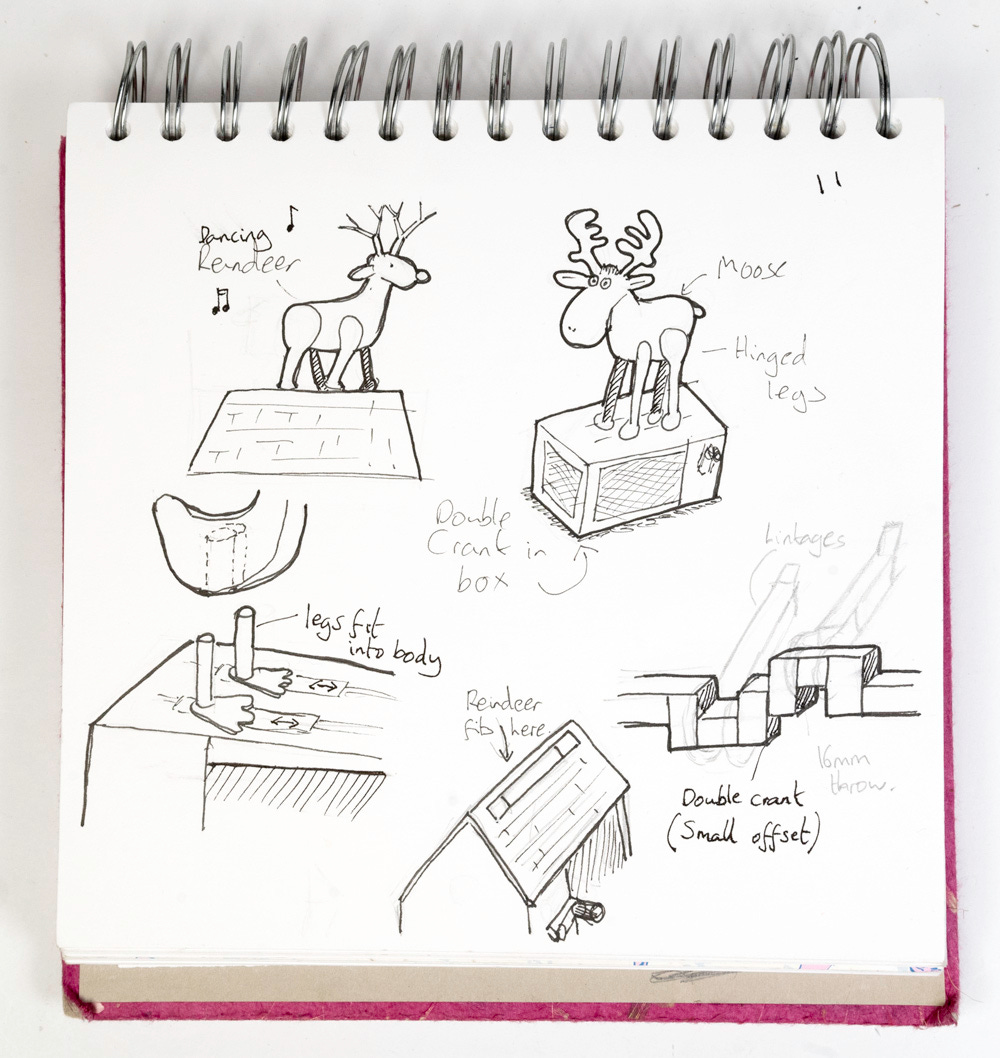Double Duck Prototype
Working with #EssentialMechanisms
It’s been great, I’ve submitted the manuscript of my forthcoming book “Making Paper Automata“ and I’ve been able to spend the last few days playing with new ideas. I’ve returned to my Essential Mechanisms as a starting point. These paper projects on robives.com are intended to be a starting point for your own automata. Each one is a mechanism in a box ready to add your own character and bring it to life. There are a whole range of essential mechanisms on the site from simple cranks to gears and Geneva mechanisms. What better place to start generating some new project ideas!?
Having looked through the various machines I decided to have a go with the Double Crank mechanism from the first page. Turn the handle and the two pads on the top of the box move back and forth in opposite directions. All sorts of possibilities for animating some character based paper projects.
My first step was to crack open the sketchbook and see what ideas I could come up with that used the double crank mechanism as a starting point
I had a notion of a pair of squirrels, one on each side of a tree trunk chasing each other back and forth, then maybe clouds parting to reveal the shining sun. The horse thing may be something I come back to in the future, I was wondering if I could make a horse that converted into a zebra by revealing some black stripes as an inner tube is slid back and forth, not related to the double crank mech but I jotted it down so I could come back to it some time. The ducks idea was the one I’ve gone with this time, more of which later.
That doesn’t mean it is the only project I’ll go forward with, I do think that the reindeer on the roof would be a fun little automata and I am fond of the sheer ridiculousness of mooses. On this page I also spent a little time thinking about how the duck project could work…
The penguin is a similar idea to the duck, I may well revisit it at some time in the future. Whilst thinking about how the pads move back and forth I had a bit of a flirtation with the idea of a pair of racks with the pinion in the centre. The pinion would be connected to a vertical shaft and would twist back and forth. Perhaps it could be used to make a character’s head twist side to side while feet attached to the pads shuffle back and forth. Could be good for a marching robot? The final sketch on the page is of two characters on either side of a wall. They look around the edge of the wall forever missing the other who is looking around the other edge. This could well be another future project.
This is the second prototype I made of the duck project, it still has some rough edges but is looking promising. I’ve decided to stick with just two ducks mainly because the ducks would need to be too small or the box too big. I’ve made some changes to the original Double Crank mechanism including making the pads that move back and forth much longer so that there is room for the two ducks. Once I’ve completed the project I’ll be releasing it as a full download, in the meantime you can download the double crank mech here. If you are a paid subscriber you can download it from the end of this newsletter.
I got to this stage with the feet glued to the sliding pads and the legs glued to the feet. I made a pair of ducks but found that they bumped into each other as they moved. Rather than rebuilding the full box I extended the moving pads with some off cuts of card. In prototype 3.0 I’ll extend the box a little so that the ducks fit neatly.
.With the duck spacing improved it is a case of dropping them in place on the legs. The leg posts fit loosely into slots in the body, The body is held in place by gravity.
The legs move back and forth the body twists from side to side making for a pleasing duck waddle.
The completed prototype works really quite nicely. Next steps will be: Extend the box and tracks as mentioned above. Tidy up the duck design. Start to look at colour rather than the current version which gets its colour from the use of coloured card.
I hope you have found this description of the design process interesting!
As always, paid subscribers to this newsletter can download the pdf at the bottom of this page - thank you for your support. Members of www.robives.com can download it for free at the website and non-members can join in the fun for £5 or equivalent here











